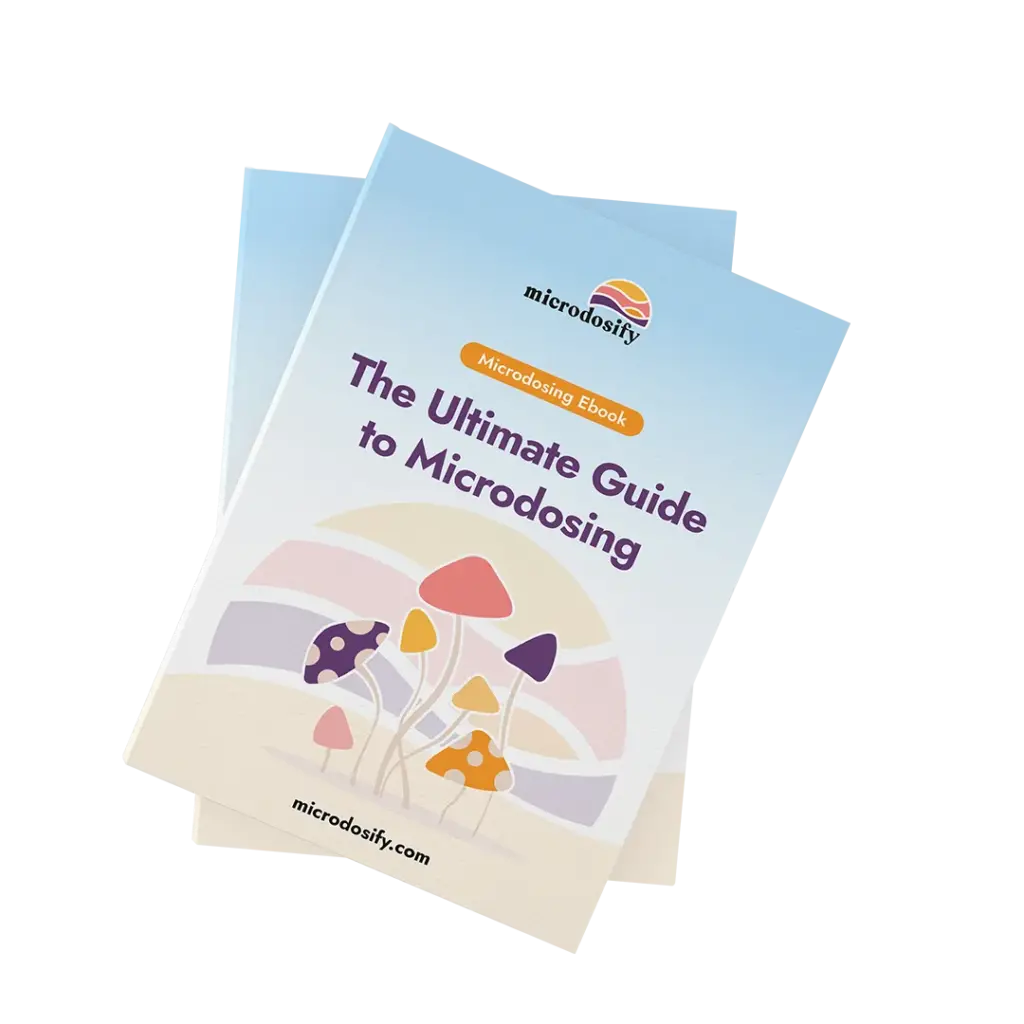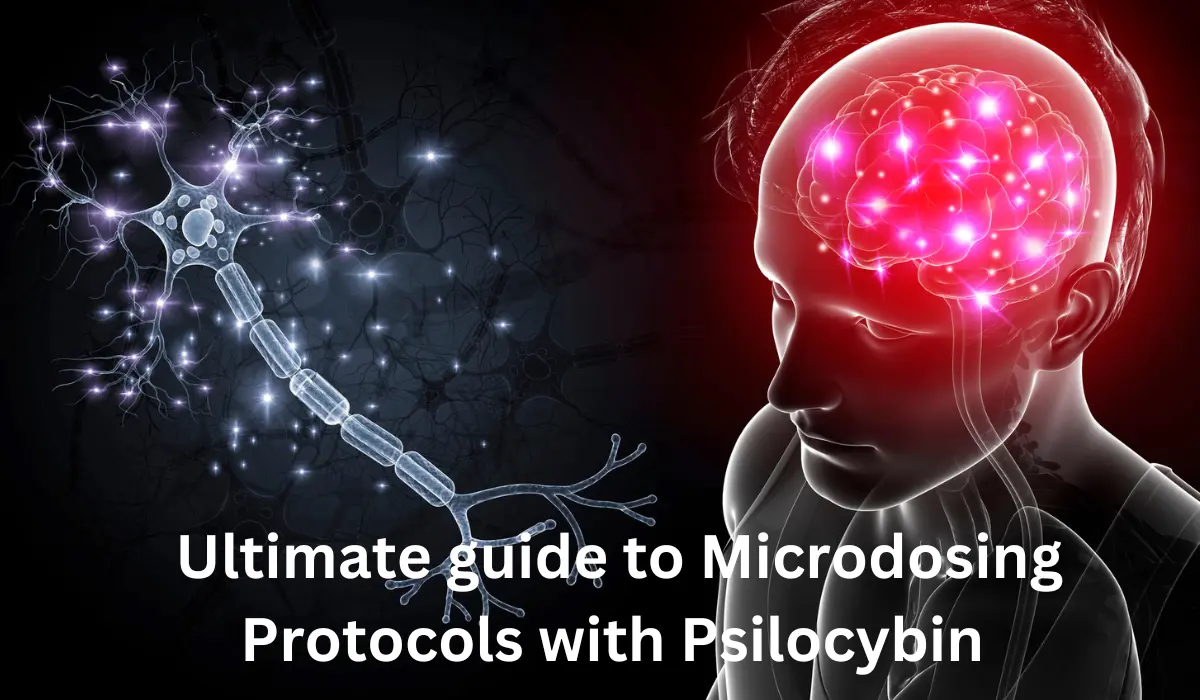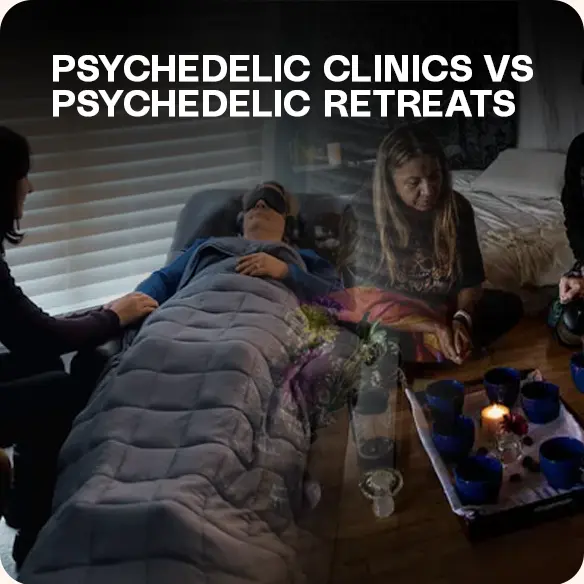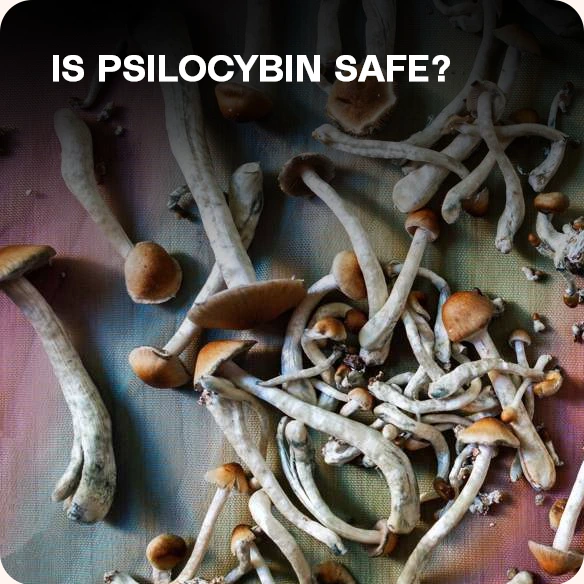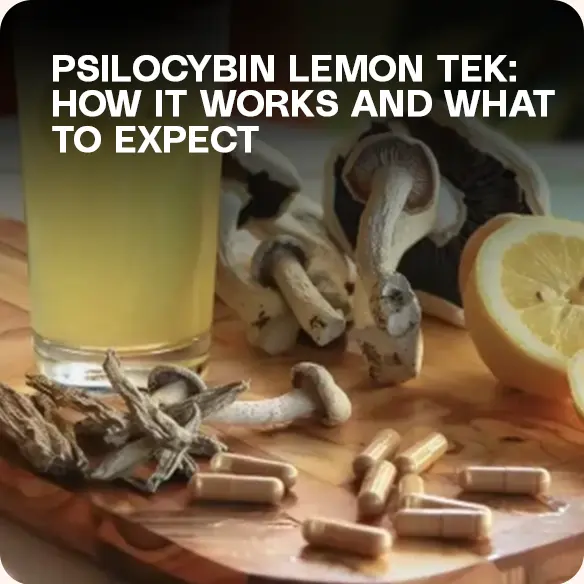Microdosing typically uses psilocybin mushrooms, part of the wider family of psychedelic compounds—leveraging their unique pharmacology and long historical use to pursue subtle cognitive and mood benefits without full psychedelic effects.
In this comprehensive guide, we delve into the most well known microdosing protocols, including:
- Fadiman Protocol: A balanced approach to microdosing
- Paul Stamets Stack: Integrating natural supplements
- Two Days a Week Method: For those seeking a minimal routine
- Every Other Day Protocol: A steady, rhythmic pattern
- Intuitive Microdosing Protocol: Listening to your body’s needs
For those interested in structured approaches, options like the CALM Microdosing Capsules can align well with routines that prioritize balance and reduced anxiety, while the CREATE Microdosing Capsules may be better suited for days dedicated to focus, ideation, or problem-solving.
Alongside these, we’ll touch upon Terence McKenna’s Heroic Dose, offering insights into this distinctive experience.
And for individuals considering deeper journeys beyond microdosing, products like ILLUMINATE provide a framework for more intentional, higher-dose explorations.
Each protocol will be accompanied by practical advice, ensuring you can make informed, responsible choices on your microdosing journey.
Let’s dive in!
What is Microdosing?
Microdosing is the practice of consuming low sub-perceptual doses of psychedelic substances, such as psilocybin mushrooms and lysergic acid diethylamide (LSD), with the aim of enhancing mental health, mood, creativity, and cognitive functions.

Unlike traditional psychedelic experiences, microdosing involves taking very low doses—often around one-tenth to one-twentieth of a recreational dose—so that the effects of microdosing remain subtle and do not produce noticeable subjective effects.
In recent years, psychedelic microdosing has gained widespread attention, with many individuals sharing anecdotal reports of significant improvements in their overall well-being, enhance productivity, and emotional balance.
These positive outcomes have sparked interest in the potential therapeutic value of low doses of LSD and other psychedelic substances for supporting mental health and cognitive functioning.
Despite the growing popularity of microdosing practices, the scientific community has only recently begun to systematically investigate the effects of microdosing through controlled studies.
A systematic review of current research highlights both the promise and the need for further investigation into the effects of microdosing on mental health, creativity, and cognitive functions.
Early findings suggest that low doses of lysergic acid diethylamide (LSD) and psilocybin may offer benefits, but more rigorous research is needed to fully understand their impact and to develop evidence-based microdosing protocols.
What is Microdosing Protocol?
Microdosing protocols refer to the frequency of consuming mildly perceptual doses of psychedelic substances, such as psilocybin mushrooms, for a period of time.

There are six common microdosing protocols, including the well-known Fadiman and Stamets protocols, each with its own unique guidelines and potential benefits.
For example, the Fadiman protocol is well suited for beginners, and the Stamets protocol may be best for advanced microdosers or those seeking to repair cognitive decline.
A systematic study of microdosing protocols is essential for understanding their safety and efficacy. Study focused research is crucial to examine the specific effects, motivations, and outcomes associated with different microdosing protocols.
What Are the Types of Microdosing Protocols?
According to microdosinginstitute.com, there are five common magic mushroom microdosing protocols or routines:
- Fadiman Protocol
- Paul Stamets Stack
- Two Days a Week Protocol
- Every Other Day Microdosing Protocol
- Intuitive Microdosing Protocol
Let’s discuss how to microdose using each protocol in detail.
Fadiman Protocol
The Fadiman Protocol(sometimes called the 2:1 protocol) is the most well-known schedule of microdosing with psychedelics such as psilocybin mushrooms.

It was popularized by a psychologist and researcher named James Fadiman. The fundamental concept is to take a tiny amount of Psilocybin, 10 to 20% of the recreational dose, once every three days.
Embarking on your initial journey into microdosing? The James Fadiman Protocol is a fantastic choice to start with.
This protocol acts as a nurturing guide for getting to know your substance and is perfectly suited for those new to the practice of microdosing.
Some users have described reported acute effects, such as subtle changes in perception or mood, following the Fadiman Protocol.
Additionally, some participants report noticeable subjective effects when following this protocol, though these effects may vary between individuals.
The Fadiman Protocol can significantly shape the subjective experience of users, influencing personal perceptions, feelings, and internal states during microdosing.
Schedule & Dosage
The recommended dosage to work with for the Fadiman protocol is 10-20% of the recreational dose, which is considered a very low dose in psychedelic research.
For example, if the recreational dose is 2g, a microdose may be 0.1g – 0.2g (100 mg-200 mg) of Psilocybin.
The specific schedule is given below:
- Day 1: Microdosing day
- Day 2: Transition day
- Day 3: Normal day / Reflection day
- Day 4: Microdosing day again
- Day 5: Continue the cycle for 1 to 2 months
- Reset: Take 2 to 4 weeks of rest (no microdosing)
Benefits, Risks & Mental Health
Benefits of the Fadiman Protocol may include increased creativity, better focus and productivity, improve mood, get positive mood, better emotional understanding, etc.—these are examples of positive outcomes reported by users of the Fadiman Protocol.
However, it is important to note that many of these are anecdotal benefits attributed to microdosing, and current scientific evidence from placebo-controlled studies is still limited.
While the Fadiman protocol is great for beginners, it’s crucial to remember that microdosing psychedelics, even in small doses, may have risks or cause unpleasant reactions in some. Some users may also experience negative emotions as a potential risk of microdosing.
A detailed list of potential risks has been cataloged by Microdosing Institute.
Paul Stamets Stack
The Paul Stamets Stack is a microdosing protocol created by mycologist Paul Stamets. This stack involves taking Lion’s Mane mushrooms and Niacin (Vitamin B3) with your psilocybin microdose.
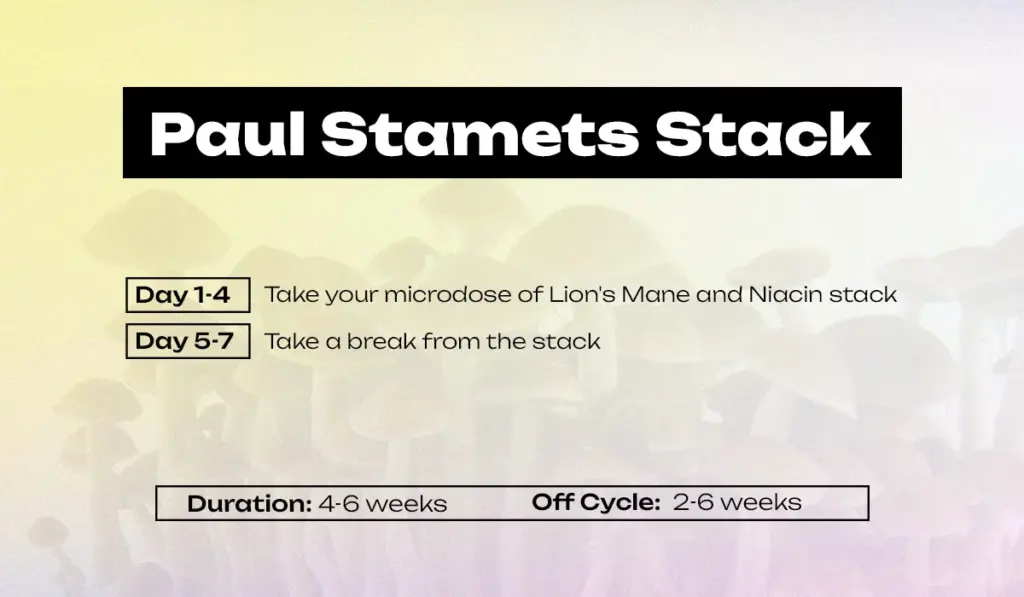
According to Microdosinginstitute.com, the Paul Stamets Stack includes the following components:
- Psilocybin Mushrooms: also known as magic mushrooms, which contain biologically active substances such as psilocybin and psilocin. Advanced chemical analysis, such as that performed at the University of Chemistry and Technology Prague, is used to characterize these active compounds and better understand their properties.
- Lion’s Mane Mushrooms: included to support neurogenesis.
- Niacin (Vitamin B3): thought to be beneficial in the distribution of psilocybin and Lion’s Mane across the blood-brain barrier.
Research has observed altered EEG rhythms in individuals taking low doses of psilocybin mushrooms, indicating changes in brain activity.
Schedule & Dosage
As suggested by Microdosinginstitute.com, the recommended dosing for the Paul Stamets Stack is 100mg – 200mg of psilocybin mushrooms, 50 – 100 mg of Lion’s Mane mushrooms, and 100 – 200 mg of Niacin (Vitamin B3).
The specific schedule of the Paul Stamets Stack is given below:
- Days 1-4: Psilocybin microdose, Lion’s Mane, and Niacin
- Days 5-7: Take a break from your psilocybin microdose and Niacin. You may continue taking a Lion’s Mane supplement indefinitely.
- Repeat this schedule for 4-6 weeks and then take a 2-6 week break.
Benefits & Risks
Paul Stamets hypothesizes that the benefits of the Stamets Protocol include improved cognitive functioning in addition to the potential benefits of microdosing with Psilocybin alone, such as increased creativity, better focus and productivity, improved mood, better emotional understanding, etc.
Some studies use the negative affect scale to assess changes in mood and emotional responses during microdosing protocols, helping to evaluate both benefits and potential risks.
According to a study done by Pit Shan Chong, The University of Hong Kong, and Man-Lung Fung, University of Malaya, on the effects of Hericium erinaceus (Lion’s mane) on depressive disorder, lion’s mane may help support recovery from depressive symptoms and depression by helping in the growth of the nerve cells and reducing inflammation in the brain. Furthermore, it may improve cognitive function and creativity.
The principal risks of the Paul Stamets Stack include sensations of heat, tingling, and itching due to high doses of Niacin.
According to an article published on academic.oup.com by Douglas MacKay and others on the topic of Niacin: chemical forms, bioavailability, and health effects, an intake of 30-50mg/day of Niacin can cause flushing effects accompanied by burning, tingling, and itching sensations.
Some studies have also observed cognitive impairment or slowed processing speeds associated with microdosing, though these effects are typically small and transient.
Additionally, Niacin should not be taken if any of the following apply to you:
- Liver disease
- Ulcerus pepticum (ulcer of stomach and/or duodenum)
- Gout
- Alcoholism
- Very low blood pressure
- Decreased kidney function
- Diabetes
Want to give the Stamets’ Stack a try? Our CALM, FOCUS, and CREATE capsules include Golden Teachers and Lion’s Mane. All you have to do is add your favorite Niacin and you’ve got yourself a stack!
Two days a week Protocol
The “Two Days a Week Protocol” is a microdosing method that suggests microdosing on two fixed days of the week (for example, every Tuesday and Saturday).
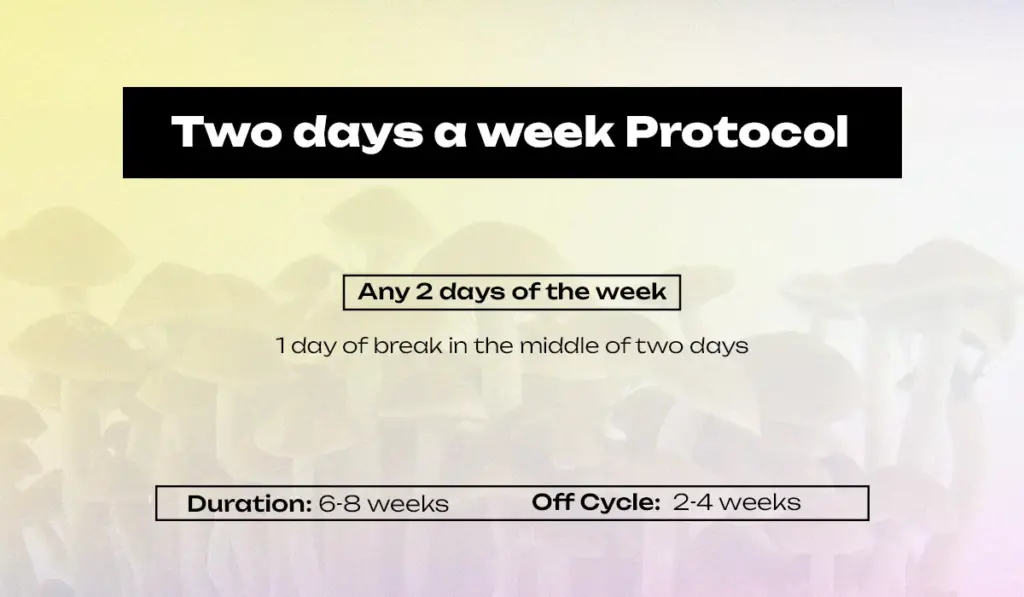
This protocol suits people who want more control over the schedule and prefer a fixed schedule to align with their daily life.
Schedule & Dosage
The recommended dose for the Two Days a Week Protocol is 10-20% of a recreational dose.
There is no specific schedule for this protocol. You are free to choose any 2 days of the week. Keep microdosing like this for 6-8 weeks, then rest for 2-4 weeks.
Benefits & Risks
The benefits of the Two Days a Week Protocol include control over one’s schedule, easier to plan, consistency, and reduced tolerance.
The main risk of the Two Days a Week Protocol is that one can develop tolerance if the protocol is not followed correctly.
Every other day Microdosing Protocol
The Every Other Day Protocol is a microdosing method suggested by the Microdosing Institute. It is also known as Microdosing Institute Protocol.
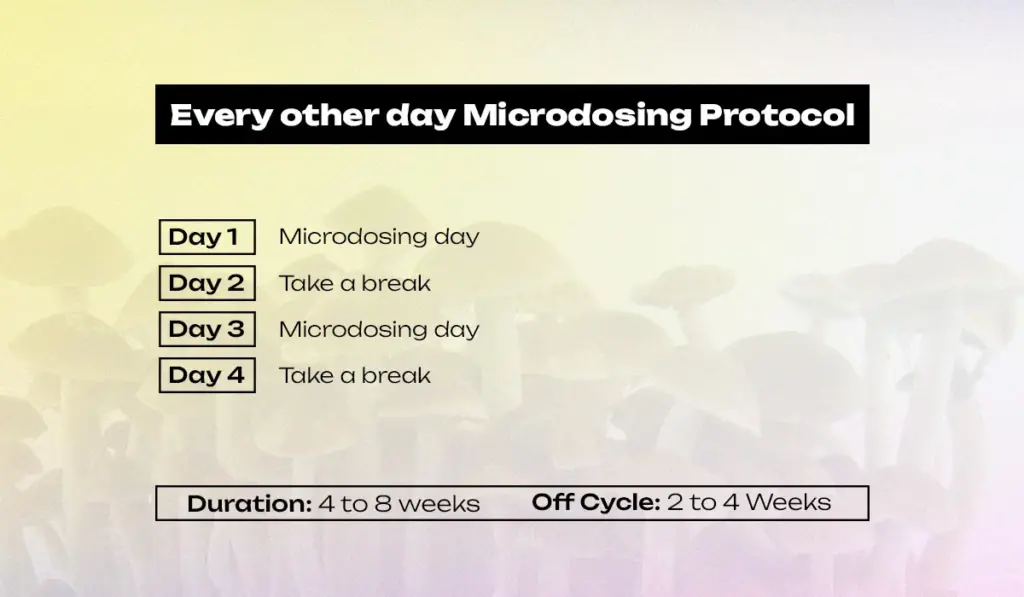
According to Microdosinginstitute.com, this protocol may be helpful for people who want to microdose for specific medical or emotional difficulties, such as depression, anxiety, ADHD, or cluster headaches, etc.
Similar protocols are also used in scientific studies with low doses of LSD to explore their effects, safety, and neurobiological mechanisms.
This protocol involves taking a low dose every other day. This protocol can also be useful for calibrating and identifying a user’s preferred dose, or sweet spot.
Schedule & Dosage
The dosage value recommended the for Microdosing Institute Protocol is 10-20% of a recreational dose.
The specific schedule for this protocol is given below:
- Day 1: Microdosing day
- Day 2: Rest day, no microdosing
- Day 3: Microdosing day
- Day 4: Rest day, no microdosing
Keep microdosing like this for four to eight weeks, then rest (no microdosing) for two to four weeks.
Benefits, Risks & Effects of Microdosing
According to the microdosing coaches at Microdosinginstitute.com, this protocol may be best supportive people who are microdosing to help ease symptoms of depression, anxiety, cluster headaches, ADHD, social anxiety, etc.
However, the effect of microdosing on these symptoms is still being studied, and current research highlights that scientific evidence regarding its benefits or risks remains inconclusive.
Ongoing research is also examining how microdosing may influence cognitive functions such as attention, perception, and problem-solving.
Some studies assess objective and subjective accuracy in perceptual tasks to evaluate the cognitive effects of microdosing.
The main risk of the Every Other Day Microdosing Protocol is that it may increase the likelihood of developing tolerance to Psilocybin mushrooms.
Intuitive Microdosing Protocol
The intuitive microdosing protocol is more suitable for experienced microdosers who have completed one or two cycles of microdosing using one of the protocols above.
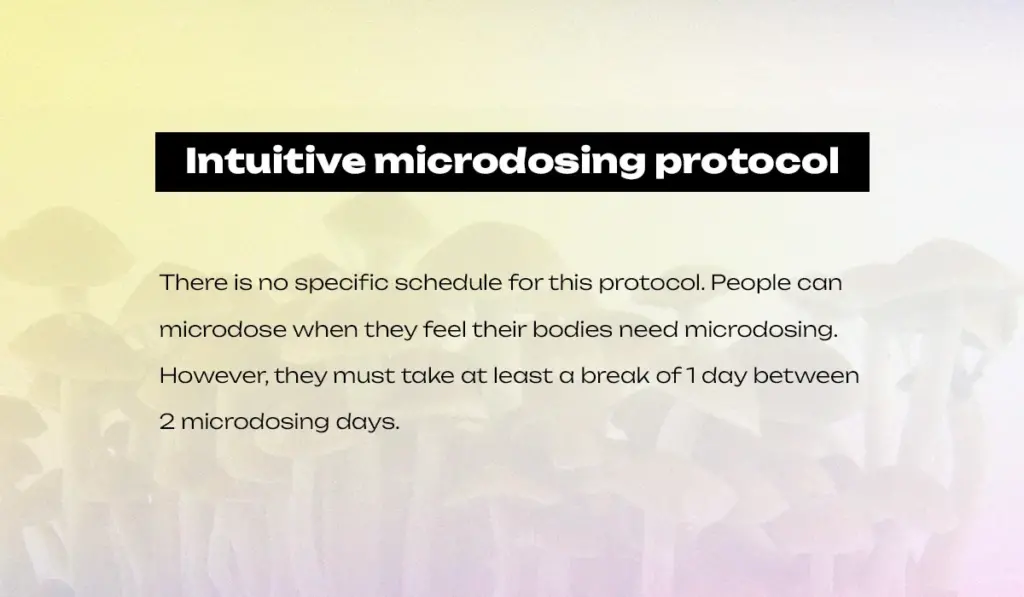
While there are no strict guidelines for this protocol, it is recommended to take a break of at least one day between two microdosing days (i.e. don’t microdose more than two days in a row).
The Intuitive Protocol often involves low sub-perceptual doses, which are tailored to individual needs and remain below the threshold for conscious perception.
Instead of a strict schedule, microdosers are encouraged to microdose when their intuition tells them it’s a great day to microdose.
Schedule and Dosage
There is no specific dosage value for the Intuitive microdosing protocol. People may choose to microdose on days that it feels great in their bodies, and often let their schedule be guided by their intuition.
Benefits and Risks
The benefits of the Intuitive microdosing protocol include flexibility of scheduling, more personalization, and suitability for experienced microdosers.
The main risk of the Intuitive microdosing regimen includes the lack of a structured schedule and the requirement for self-monitoring.
Terence Mckenna’s Heroic Dose – A Macrodose protocol
Terence McKenna’s Heroic Dose is a macrodose method created by Terence Mckenna. The heroic dose is a hefty dose of 5g of Psilocybin mushrooms.

Instead of low doses, Terence Mckenna suggests taking heroic doses of 5g of dried psilocybe cubensis mushrooms and lying in the dark with your eyes closed.
He suggests this high dose to bring you out of your present reality and explore your mind without distractions. Higher doses like the Heroic Dose produce much more intense and transformative effects compared to microdosing.
Individuals with a history of primary psychotic disorder should avoid high-dose protocols like the Heroic Dose due to potential risks.
Schedule & Dosage
According to Terrence Mckenna, the dosage value for McKenna’s Heroic Dose is 5mg of dried psilocybe cubensis mushrooms.
There is no specific schedule for this heroic dose. Terence suggests taking it infrequently and, at most, 2-3 times a year. The heroic dose is not suitable for casual and frequent use.
Benefits & Risks
Terence McKenna’s Heroic Dose benefits may include life-changing and transformative experiences, improved emotional well-being, self-discovery, and spiritual enlightenment. But remember, it is not a beginner’s protocol.
The risks of Terence McKenna’s Heroic Dose may include confusion, emotional challenges, lack of clinical trials, and chances of experiencing psychological trauma. Embarking on a heroic dosing journey may not be the most ideal initiation for beginners.
Please note that a heroic experience is vastly different from microdosing. Microdosing should not produce classical psychedelic effects that a heroic dose may induce.
A therapeutic dose, on the other hand, is typically lower than a Heroic Dose and is used in clinical settings for mental health treatment.
Clinical studies have explored the use of high-dose psilocybin for treatment resistant depression, with some promising results.
What Are the Study Design and Methodology in Microdosing Research?
The study design and methodology in microdosing research vary widely but increasingly focus on rigorous approaches to accurately assess the effects of low doses of psychedelic substances.
Early studies often relied on self-reported surveys, which, while valuable for gathering broad user experiences, are limited by biases and lack of control groups.
To overcome these limitations, recent research emphasizes the use of double-blind placebo controlled trials, considered the gold standard, to minimize bias and improve the reliability of findings.
In a placebo controlled trial, neither the subjects nor the investigators know the treatment allocation until the data analysis stage, ensuring a rigorous blinding process.
The data analysis stage is when the collected data are examined and interpreted before reporting results.
These controlled studies utilize objective measures such as functional magnetic resonance imaging (fMRI), resting state EEG analysis, and standardized cognitive tests like the Remote Associates Test (RAT), Creative Personality Scale (CPS), and Cognitive Flexibility Scale (CFS).
Despite these advances, the placebo effect remains a challenge, underscoring the need for careful data analysis and multiple comparisons to distinguish true psychedelic microdosing benefits from expectation-driven outcomes.
Future research should continue to refine methodologies with larger sample sizes and systematic reviews to establish clear evidence-based guidelines for microdosing protocols.
Early Research: Surveys and Self-Reports
Initial microdosing studies primarily used online surveys and self-reported questionnaires to collect data from individuals practicing microdosing psychedelics.
These studies often report significant improvements in mood, creativity, and well-being but are limited by small sample sizes and potential biases, making it difficult to isolate the effects of microdosing from other influences.
Advancements: Double-Blind Placebo-Controlled Trials
To address the limitations of earlier research, recent studies employ double-blind placebo-controlled designs.
In these trials, neither participants nor researchers know who receives the active substance or placebo, reducing bias.
Such studies have demonstrated significant differences in mental health outcomes, with some showing improved mood, reduced anxiety, and enhanced cognitive function following low doses of LSD or psilocybin.
Objective Measures and Cognitive Testing
Complementing subjective reports, researchers use neuroimaging techniques like fMRI and EEG to assess brain activity changes during microdosing.
Cognitive assessments including RAT, CPS, and CFS evaluate divergent and convergent thinking, creativity, and cognitive flexibility, providing a comprehensive understanding of microdosing’s impact on cognition.
Challenges and Future Directions
The placebo effect poses a significant challenge in microdosing research, as participants often report positive outcomes even with placebos.
This highlights the necessity of placebo controls and rigorous data analysis. Future studies should focus on larger, well-controlled trials and systematic reviews to clarify the therapeutic value and safety of microdosing psychedelic supplements, ultimately informing evidence-based microdosing protocols.
Controlled Studies and Data Analysis
Controlled studies, particularly double-blind placebo-controlled trials, are crucial for accurately assessing the effects of microdosing psychedelic substances on mental health and cognitive functioning.
In these studies, participants receive either a low dose of a psychedelic substance—such as psilocybin or lysergic acid diethylamide (LSD)—or a placebo, without knowing which they have received.
This approach helps to eliminate bias and ensures that any significant differences observed in outcomes can be attributed to the active dose rather than external factors or expectations.
Researchers use a variety of standardized tools to measure the effects of microdosing, including the Positive and Negative Affect Schedule (PANAS) and the Perceived Stress Scale (PSS), which assess changes in mood and stress levels.
Data analysis from these controlled studies can reveal whether there are significant improvements in mental health, mood, or cognitive functioning among those who receive the active dose compared to the placebo group.
The results of these trials are essential for distinguishing the true effects of microdosing from placebo effects and for identifying any potential risks or negative outcomes.
As the field of psychedelic research continues to evolve, future research should prioritize well-designed controlled studies and systematic reviews to provide a clearer understanding of the therapeutic value and safety of microdosing.
This evidence-based approach will help guide the development of effective microdosing protocols and support improved mental health outcomes for those seeking alternative approaches to well-being.
What is Psychedelic Microdosing and What Are Its Applications?
Psychedelics microdosing refers to the practice of consuming very low doses of psychedelic substances, most commonly lysergic acid diethylamide (LSD) and psilocybin, with the intention of enhancing well-being without inducing the full-blown psychedelic experience.
Over recent years, this approach has gained significant attention for its potential to support mental health and cognitive function.
According to the global drug survey and its key findings report, psychedelics microdosing practices are becoming increasingly prevalent worldwide, providing valuable data on usage patterns and attitudes.
Many individuals who engage in psychedelics microdosing report significant improvements in their overall mood, reduced symptoms of anxiety and depression, and enhanced cognitive abilities such as focus, creativity, and problem-solving.
Some studies have found a significant difference in outcomes between microdosing and control groups, though results are often mixed.
These positive effects of microdosing are often attributed to the sub-perceptual doses of LSD and psilocybin, which are believed to gently influence brain chemistry and support improved mental health outcomes.
While the therapeutic value of psychedelics microdosing is promising, it’s important to note that much of the current understanding comes from anecdotal reports and personal experiences shared within the microdosing community.
Although these stories highlight the potential benefits, there is a growing call for more systematic research and double blind placebo controlled studies to objectively assess the effects of microdosing and determine its safety and efficacy.
Placebo effects can account for some of the perceived benefits of microdosing, highlighting the importance of controlled studies.
Research in this area often utilizes tools such as the CFS Cognitive Flexibility Scale, CPS Creative Personality Scale, FSS Flow State Scale, PSS Perceived Stress Scale, stress scale, physical activity analysis, local global ERP analysis, and RAT Remote Associates Test to assess various psychological and physiological outcomes.
As interest in psychedelics microdosing continues to rise, further research will be essential to fully understand the long-term effects and mechanisms behind these reported improvements and to establish evidence-based guidelines for safe and effective microdosing practices.
For now, the field remains an exciting frontier in psychedelic research, with the potential to unlock new therapeutic options for mental health and cognitive enhancement.
Which Microdosing Protocol is the best?
There is no one protocol that is the best of all. Each microdosing protocol has its benefits and risks. The best protocol can change from person to person based on their needs.
For example, The Fadiman Protocol is best suited for the beginner. An advanced microdoser might get more perceived benefit out the Paul Stamets stack of the Intuitive protocol.
Two days a week Protocol can be the best for the people who want to control the schedule.
Terence Mckenna’s Heroic Dose can be considered the best for people who want to experience enlightenment.
The best Protocol is very subjective and depends upon individual needs.
Positive expectations can also influence the perceived benefits of any protocol, as mindset and beliefs may shape the overall experience.
So, try a protocol for one or two months and decide which is best for you.
If you’re new to microdosing or still exploring what works for you, the Starter Pack is a great way to experiment safely with different blends and protocols over one or two months.
How to know which microdosing protocol works for you?
Choose a microdosing protocol by schedule, goals, and experience. Beginners start with Fadiman for 1–2 cycles. For symptoms, try Every-Other-Day; for advanced users, Stamets or Intuitive.
Track doses and outcomes, use pre/post measures, and switch or consult if adverse effects.
To determine which microdosing protocol works best for your needs, consider the following factors:
- Your schedule: Some protocols, such as Two days a week and the intuitive protocol, are flexible and give you more control over the microdosing schedule.
- Your goals: If you are seeking to ease symptoms associated with depression, anxiety, ADHD, or cluster headaches, for example, then the Every Other Day (Microdosing Institute Protocol) may best suit you.
- Your experience: If you are a beginner, the Fadiman protocol is a great starting protocol, and if you are experienced or advanced, the Paul Stamets stack or intuitive protocol may enhance your practice.
If you are still trying to decide which protocol is for you, then start with the Fadiman protocol for one or two cycles. Keep tracking and journaling your experience during the cycles.
Using post study measures can also help you objectively assess the effectiveness of your chosen protocol. After two cycles, if you feel some adverse effects, change the protocol or take a consultation with an expert.
Final Thoughts and Future Research on Microdosing Protocols
Each microdosing protocol has its own guidelines, schedule, benefits, and risks. One should consider their goal, schedule, and experience before choosing a particular protocol.
Some protocols may be more beneficial for mental health conditions, whereas others give schedule flexibility.
Especially as a beginner, it is recommended to track and journal your experiences while microdosing. Self-monitoring is essential in getting the most out of your microdosing practice.
However, it is important to note that current research does not conclusively show that microdosing protocols support enhanced well being, and more studies are needed to determine their effectiveness.
Now that you’re comfortable with microdosing protocols, it’s time to begin your microdosing journey! Check out one our signature blends to get started:
- Find inner peace with Calm
- Achieve peak cognitive performance with Focus
- Unleash your inspiration with Create
References:
- Chong, P. S., Fung, M., Wong, K. H., & Lim, L. W. (2019). Therapeutic Potential of Hericium erinaceus for Depressive Disorder. International Journal of Molecular Sciences, https://www.mdpi.com/1422-0067/21/1/163
- CORI SUE MORRIS. APRIL 2, 2023. Microdosing Protocols: The Fadiman Protocol. Retreat Microdose,
- https://www.retreatmicrodose.com/media/the-fadiman-microdosing-protocol
- Microdosing Community. (2022, August 29). Microdosing Protocols — Fadiman, Stamets, and more. Microdosing Institute.
- https://microdosinginstitute.com/how-to/microdosing-protocols/
- MacKay, D., Hathcock, J., & Guarneri, E. (2012). Niacin: Chemical forms, bioavailability, and health effects. Nutrition Reviews, 70(6), 357-366, https://doi.org/10.1111/j.1753-4887.2012.00479.x
- Office of Dietary Supplements. (n.d.). Niacin. Office of Dietary Supplements – National Institutes of Health. Retrieved from https://ods.od.nih.gov/factsheets/niacin-healthprofessional/
- Microdosing Protocols | Microdose Pro. (2022, November 21). Microdose Pro. https://www.microdose-pro.com/microdosing-protocols/
- Griffin, R. M. (2013, October 20). Saffron: Uses and Risks. WebMD. https://www.webmd.com/vitamins-and-supplements/saffron-uses-and-risks
- Anais, A. (2023, May 8). Everything You Need To Know About Choosing A Microdosing Protocol. Microdose Guru. https://www.microdoseguru.com/post/everything-you-need-to-know-about-choosing-a-microdosing-protocol
Frequently Asked Questions
1. How do you get started microdosing?
To get started with microdosing, decide why you want to microdose. Once you have a clear goal that you want to achieve, choose a microdosing protocol that best suits your goal, schedule, and experience. Most people choose the Fadiman Protocol as their starting point.
2. Can you create your own microdosing protocol?
Yes, you can follow your own unique microdosing schedule. The intuitive protocol is a personalised microdosing schedule.
3. Is there a microdosing protocol without magic mushrooms?
Yes, there are microdosing protocols without magic mushrooms. Microdosing schedules are substance-agnostic. The protocols described in this article can easily be used with other psychedelic substances such as LSD. Microdosing psychedelic supplements, including LSD, is also common, especially among professionals seeking enhanced creativity, productivity, and mental health benefits.
4. Can you stack other substances with magic mushrooms?
Yes, you stack other substances or supplements with magic mushrooms. The Paul Stamets Stack is one such example that stacks magic mushrooms with Lion’s Mane and Niacin (Vitamin B3). Practicing safe substance testing behavior is recommended to ensure the authenticity and safety of the substances used.
5. What shrooms are commonly used for microdosing protocol?
Shrooms that contain Psilocybin are commonly used for microdosing protocol. Magic mushrooms and their different strains, such as Psilocybe cubensis, Psilocybe semilanceata, and Psilocybe azurescens are best.
6. Should I use the term “microdosing psychedelic drugs” or “microdosing psychedelic supplements”?
The term “microdosing psychedelic drugs” refers to taking low doses of classic psychedelics like LSD or psilocybin mushrooms. In contrast, “microdosing psychedelic supplements” includes natural compounds like Lion’s Mane or Niacin used alongside psychedelics. Use “psychedelic drugs” for the active substances and “psychedelic supplements” when discussing combined or supportive substances in microdosing protocols.
